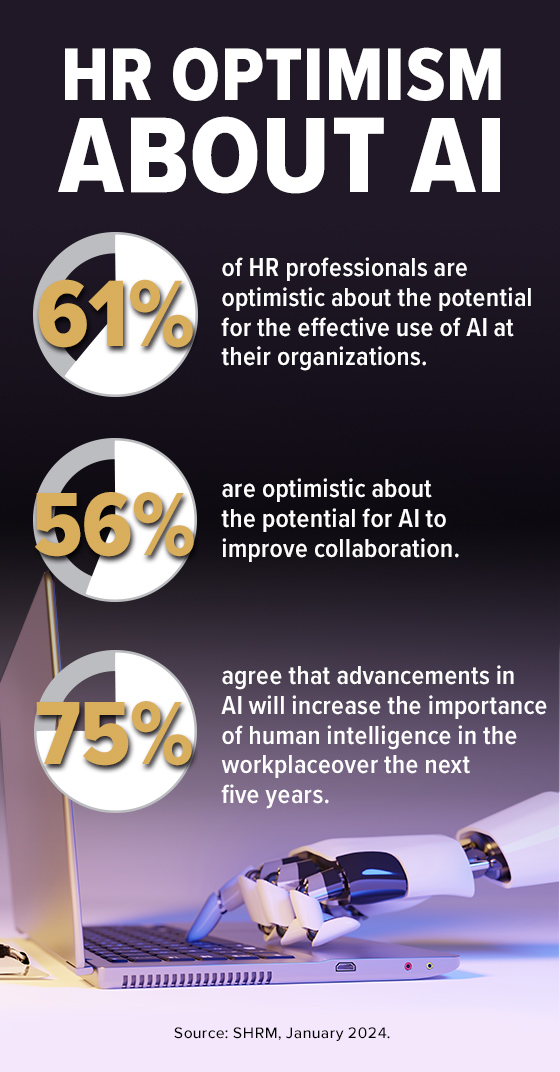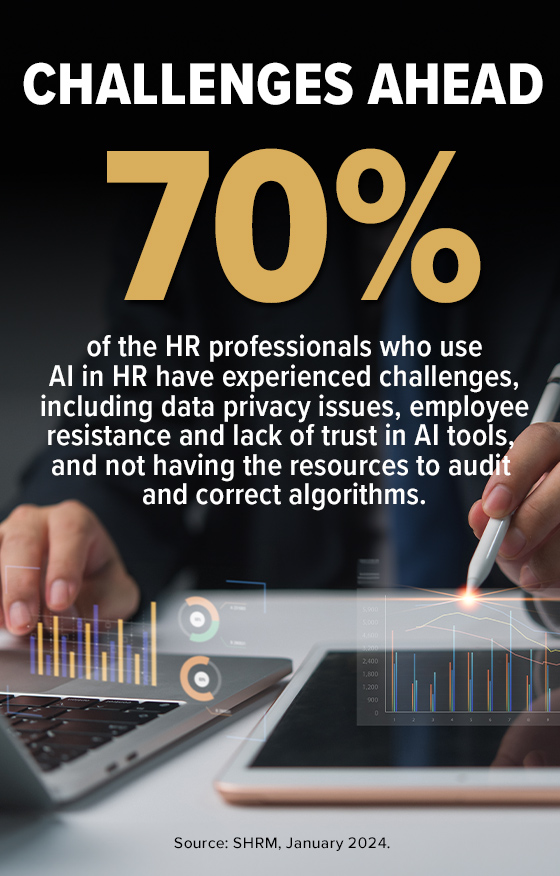HR Adopts AI
For the tech to be successful, employers must be thoughtful about its use.

The widespread rollout of generative artificial intelligence (GenAI) tools has led to an explosive growth in the use of AI technology in the workplace.
And while HR and business leaders have withstood the emergence of disruptive technologies before, the adoption of AI is predicted to pose huge challenges and necessitate major reskilling efforts to address shifting talent needs.
About 1 in 4 organizations are currently using AI to support HR-related activities, but the majority of those organizations began using the technology within HR during the past 12 months, according to research from SHRM.
Nearly half of the surveyed HR professionals said using AI to support HR has become somewhat or much more of a priority in the last year. The survey was conducted in January 2024 among 2,366 HR respondents representing organizations of all sizes in a wide variety of industries across the U.S.
The study found that AI has been adopted most readily at the largest organizations (those with 5,000 or more employees) and among the technology, finance and information industries. Among organizations that use AI, nearly 30 percent have been proactive in training and upskilling employees to work alongside AI technologies.
Most HR professionals are optimistic about the potential for AI, according to the research: 61 percent are optimistic about the potential for the effective use of AI at their organization, and 56 percent are optimistic about the potential for AI to improve collaboration. 75 percent of respondents agree that advancements in AI will increase the importance of human intelligence in the workplace over the next five years.
Implementing AI focused only on optimization works to increase profitability, but it misses the opportunity to reinvent, says Nichol Bradford, executive-in-residence for AI+HI at SHRM, where she shapes thought leadership on human-AI collaboration. “Today’s AI will not identify the opportunities to reinvent your value chain or make a customer touchpoint more meaningful in a way that converts to more business. It will not establish and deepen trust between you and your customers in a way that makes them unwilling to consider your competitors. Your people will do that for you.”
But some work currently being performed by employees can be done faster by machines, she adds.
“You need their help to reinvent those jobs, to do the workflows and task analysis to properly divide, automate, augment or enhance in the specific context of your business,” Bradford says.
Job Losses Ahead?
A recent Gartner study found that the number of HR leaders in the latter stages of the GenAI implementation process, which includes pilot programs, planning and post-implementation, is up twofold from June 2023 to January 2024.
“The top three areas in which HR leaders believe GenAI will drive benefits include increased HR productivity, improved employee experience and driving innovation,” says Eser Rizaoglu, senior director and analyst in Gartner’s HR practice.
Yet some in HR (24 percent) are concerned that AI will lead to job displacement, according to the SHRM study.
That concern aligns with separately published SHRM research that forecasts increased productivity and job role transformation in the coming years, with layoffs and hiring slowdowns being the cost of that surge as employers adjust to a new reality. Some point out that the layoffs happening now in the technology sector may be due to AI because companies feel the need to quickly pivot to develop the emerging technology.
It won’t be a zero-sum game. … Certain tasks in recruiting and HR service centers will become automated, but the largest amount of change will be in the evolution of roles.”
— Jeanne Meister
At this point in time, however, respondents to the SHRM survey who work at organizations that use AI are much more likely to say that AI is transforming existing jobs rather than displacing jobs at their company.
“It won’t be a zero-sum game,” says Jeanne Meister, a global HR consultant and thought leader on the future of work. “Some occupations will shrink, some will grow, and others will evolve with new roles, reskilling and job redesign. Certain tasks in recruiting and HR service centers will become automated, but the largest amount of change will be in the evolution of roles.”
Rizaoglu agrees, forecasting an augmentation of HR roles, especially in recruitment, learning and development, and HR shared services.
Bradford says that “AI has the potential to expand employment, but that depends on how we go about layering it into our companies. You can’t promise that no one will lose their jobs when roles shed tasks, but you can offer to work with them to replace tasks with ones that add profitability and thereby reduce the likelihood of them no longer being employed with you.”
That is the crux of skills-based versus task-based jobs.
“Today, jobs are a collection of tasks, some of which cannot be done by AI and some of which can,” Bradford says. “We typically define our jobs by our tasks rather than our creations or our skills. No wonder it’s frightening to hear that AI can accomplish many of the same tasks that we do. However, when we switch how we think about jobs to view them as points of creation—new products, new businesses, new customers—then it becomes easier to see AI as an opportunity.”
Don’t Lose What’s Human About Work
When respondents were asked why their organization is not using AI technology to support HR, they said there’s a lack of knowledge about how AI tools could help, there’s a lack of resources to properly audit AI algorithms and AI would remove the “human touch.”
“AI should absolutely not be used to replace tasks that require the human touch,” Bradford says. “If a human-touch task is being considered for replacement by AI, that company is making a big mistake that I believe will cost them later. The purpose of AI in HR is to begin to shed the tasks you didn’t sign up for so you can do more of the things you hoped to do.”
If a human-touch task is being considered for replacement by AI, that company is making a big mistake that I believe will cost them later.”
— Nichol Bradford
About 70 percent of respondents to the SHRM survey that use AI in HR have experienced challenges, including data privacy issues, employee resistance, a lack of trust in AI tools, and not having the resources to audit and correct algorithms.
Rizaoglu advises that HR leaders introduce a new role to manage HR’s AI initiatives and provide a guiding north star.
“Having a dedicated role within HR, potentially sitting within the HR IT subfunction, is becoming more important, as it can help coordinate and plan GenAI efforts for the HR function and help build an HR AI strategy while also working with key cross-functional stakeholders and HR tech vendor partners to mitigate risks and implementation challenges,” he says.
How HR Uses AI
Among the organizations that have adopted AI for HR purposes, talent acquisition is the top area for its use (64 percent), followed by learning and development (43 percent), and performance management (25 percent), according to the SHRM study.
Talent acquisition. “Within the spectrum of HR roles, talent acquisition is always the group to innovate first,” says Ben Eubanks, principal analyst and chief research officer at Lighthouse Research and Advisory, based in Huntsville, Ala. “Talent acquisition is metrics-driven and has a ton of data between job postings and candidates, so vendors have something to train AI models on. Recruiting was a logical place for AI to get started.”
Of those who use AI for recruiting, 65 percent are using it to help generate job descriptions; 42 percent are using it to customize job postings; and 33 percent are using it to review or screen applicant resumes, communicate with applicants during the interview process, or automate candidate searches. Recruiters said it saves them time and increases their efficiency, improves their ability to identify top candidates, and reduces their recruitment costs.
More-transactional recruitment roles have been most impacted by AI. “Remember those people doing candidate scheduling?” Eubanks says. “Those roles are largely gone now because of automation and AI. Algorithms can do that job faster and with more consistency.”
Eubanks says that sourcing—which can be data intensive and repetitive—has also been affected because AI can quickly make candidate matches through a variety of different search lenses.
AI is expected to further redefine the recruiter’s role in both routine administrative tasks and strategic and analytical decision-making. Recruiters can finally achieve the aspiration of evolving into talent advisors, leveraging data insights to evaluate candidates, guide hiring managers and shape talent strategy.
But recruiters should not be using the technology without safeguards, Eubanks says. “AI users need to keep their hand on the wheel to make the best choices. That goes for all HR functions. Letting technology do all the work is a danger zone,” he says.
Eubanks is also worried about junior recruiters. “In the past, they were the ones who had to write outreach messages that connected with candidates and do other entry-level tasks,” he says. “Now ChatGPT does that. The recruiter is not building those lower-order but still valuable skills, so when they move on to higher-order tasks, they won’t have the foundation or the confidence that recruiters previously had. What does that mean for the future of recruiting and HR?”
Learning and development. Among organizations that use AI to support learning and development (L&D) activities, 49 percent are using AI to recommend or create personalized opportunities for their employees, 45 percent are using it to help track employees’ learning progress, and 19 percent are using it to upskill or reskill their workforce. Many respondents mentioned that AI is a great tool for helping them build out new training content and programs.
“Every L&D vendor is applying AI to content creation—brainstorming ideas, outlining coursework content and drafting entire courses,” says Dani Johnson, co-founder and principal analyst for RedThread Research, an HR analyst firm in Woodside, Calif.
Coaching—traditionally a relationship between two humans—is also being remade by AI, she says. “There are examples of bots replacing human coaches and augmentation of human coaches. Instead of a human coach having to have everything in her head and take copious notes, the AI is helping her generate questions or prepare information for follow-up sessions,” Johnson says.
She says another training function undergoing change is “employee nudging,” which is tools that can give feedback and direction in the flow of work.
“Technology takes unorganized data and gives employees a better understanding of what is going on,” Johnson says. “For example, it can sit on an email system and alert someone if they are frequently communicating with a colleague too late at night. Another example is at Amazon—if someone misses a few package scans, a short video will pop up on their device to provide them with tips to correct the issue.”
The big L&D vendors are creating content faster and improving efficiencies, but they are also looking to transform how we view skills, Johnson says.
“GenAI can be used to generate skills taxonomies and analyze skills gaps more quickly and determine what a job structure should look like more easily,” she says. “GenAI can finally align skills to learning and make learning more effective than it’s ever been before.”
Performance management. Among organizations that use AI to support performance management, many are using it to help facilitate performance conversations and next steps, including 57 percent who are using AI to assist managers in providing more comprehensive or actionable feedback to their employees and 46 percent who are using AI to facilitate employee goal setting.
“Performance management is a very interesting use case for AI,” Meister says. “AI will not only increase efficiency by reducing the labor-intensive parts of the process but, more importantly, improve the performance review itself by helping to remove subjectivity in the evaluation.”
One of the ways that is happening is through sentiment analysis, Eubanks says: “Let’s say the manager gave John a 2 out of 5 on his performance review, but then had only good things to say about John in the comments. AI flags the review to be rectified because of the incongruence.”
Eubanks adds that with the onset of tools like ChatGPT, more managers are using GenAI to help them write performance reviews.
“That’s not a problem for outlining thoughts or writing a first draft, but managers should not be just handing off AI-written reviews to their employees,” he says. “I’m seeing vendors requiring managers make substantial inputs to reviews before they move it on.”
Performance management is a very personal interaction, Eubanks says. “Vendors have begun putting guardrails in, because to be honest, many managers would like to just have the easy path and have the AI write the reviews,” he says.
But Eubanks is excited about the future of AI in managing performance: “AI and analytics can elevate performance management from a compliance- and task-focused topic to something more enduring, like enabling people to improve their performance.”
 |
The majority of organizations purchase their artificial intelligence tools from vendors, according to the SHRM study. But only 1 in 3 respondents who do so said their vendors are very transparent about the steps taken to ensure that the tools prevent or protect against discrimination and bias. “Lack of transparency is a big problem,” says Dani Johnson, co-founder and principal analyst for RedThread Research, an HR analyst firm in Woodside, Calif. “Another caution is around privacy. GenAI takes a lot of data to work, and securing that data is a big concern. There is a big potential for disaster if we get this wrong.” Ben Eubanks, principal analyst and chief research officer at Lighthouse Research and Advisory, based in Huntsville, Ala., says that both workers and their employers want to feel secure and protected when employment decisions are being made using AI technology. “One way that vendors are solving the black-box problem is that whenever the technology surfaces a recommendation—and the tools should be making recommendations, not making decisions—it does so in context with helpful information on where that recommendation came from,” he says. “Responsible AI” is a growing area of responsibilities and practices that ensures positive, accountable, and ethical AI development and operation, says Eser Rizaoglu, senior director and analyst in Gartner’s HR practice. “When AI replaces human decisions and generates brand-new artifacts, it amplifies both good and bad outcomes,” Rizaoglu says. “Responsible AI enables the right outcomes by ensuring business value while mitigating risks. This requires a set of tools and approaches, including industry-specific methods, adopted by vendors and enterprises.” Rizaoglu offers some recommendations for HR:
|
Roy Maurer is senior specialist, B2C Content, at SHRM.




